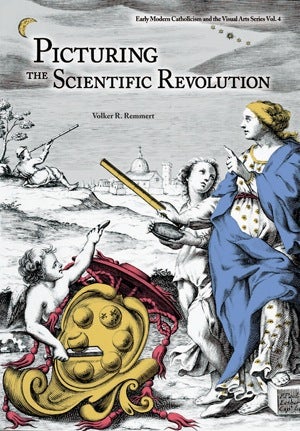
Picturing the Scientific Revolution; - Title Engravings in Early Modern Scientific Publications
Price: $65.00
Place Published: Philadelphia
Publisher: Saint Joseph's University Press
Date Published: 2011
ISBN: 9780916101671
Book ID: 51
Description:
Early Modern Catholicism and the Visual Arts Series, Vol. 4
259 pages + bibliography and index | 11 x 7.5 inches | 109 color and b/w images
This volume is an English translation, with slight changes to the text and the addition of several images, of Volker Remmert's study, first published in German in 2005, of the role of frontispieces, engravings, and visual emblems in early modern publications on the mathematical sciences. The author's selection of images is guided by two themes: the dispute over the Copernican system during the 17th century, and efforts to legitimize the mathematical sciences. Both Catholic, especially Jesuit, as well as Protestant scholars are studied, giving this work an appeal across the confessional divide.
CRITICAL ACCLAIM
"This original and persuasive work, beautifully illustrated and well documented, was originally published in German in 2005; Ben Kern has provided a fluent and very readable English translation. It is a welcome addition to the historiography of the scientific revolution."
Eileen Reeves, Print Quarterly
"Like the texts and images that are Volker R. Remmert's historical subject, the author provides a kind of 'explanatio imaginum' that brings out the contextual meanings implied in the pictures he examines. The book is handsomely constructed and well annotated with numerous references to historical sources and secondary interpretations drawn from the ranks of historians of science and art. [...] [T]his book leads the reader into the beautiful world of early-modern representations of scientific ideas."
Kenneth J, Howell, Catholic Historical Review
Volker Remmert's remarkable Picturing the Scientific Revolution is a sumptuous book, which deals with a sumptuous subject. […] As a reader and interpreter of individual images, Remmert is magnificent. He deploys an arsenal of learning, understanding, and insightful commentary, and any student of the visual culture of late sixteenth- and seventeenth-century Europe — particularly Catholic visual culture — will be enlightened by this work's scholarship. Picturing the Scientific Revolution will function as a valuable addition (and sometimes a corrective) to the work of (among many others) Peter Burke, Martin Kemp, Horst Brederkamp, Roger Chartier, Margaret Smith, and Adrian Johns, as well as commending itself as an important and highly significant contribution to the general field of emblem studies, book history, and the study of the cultural and intellectual context of the "new philosophy" of the seventeenth century. […] Volker Remmert has produced a wonderful book, for which we shall be in his debt for many years to come.
Jonathan Sawday, Emblematica
"This study of early modern title-page and frontispiece images is a welcome translation of Remmert's 'Widmung, Welterklärung und Wissenschaftslegitimierung: Titelbilder und ihre Funktionen in der wissenschaftlichen Revolution', published in 2005. [...] The work provides a useful source of reference, containing over a hundered (predominantly Continental) title-page illustrations in the mathematical sciences. It also provides excellent examples of how such material can be used to shed new light on some canonical discussions."
N. Kaoukji, British Journal for the History of Science
"This book is both aesthetically beautiful and important for reserach. [...] It's a magnificdent book, which provides, in each chapter, sometimes daring perspectives and new insights, based on evidence supported by numerous carefully selected, apt, and well chosen images and illustrations."
Sylvie Taussig, Bibliothèque d'Humanisme et Renaissance
PRAISE for the German edition of Volker Remmert's Picturing the Scientific Revolution:
"In this handsomely produced book, Volker Remmert impresses, fascinates, and delights the reader with his vast knowledge of the way mathematics evolved into a leading scientific enterprise over the course of the seventeenth century. His careful analysis of the frontispieces of mathematical (astronomical, optical, and treatises about the art of war and garden architecture) books presents an expose of the early modern symbiosis between mathematics and art. It is a model of an interdisciplinary investigation in which history, art history, and the history of science join in an act of mutual enlightenment. Remmert explicates in minute and instructive detail the surprisingly subtle interactions of word and image implicit in the iconotexts (Peter Wagner) of the title pages, revealing mathematics' iconographic connections to mythology, art, theology, and philosophy and demonstrating how they were employed to communicate changing scientific assumption while holding on to theological orthodoxy. […] This book is beautifully produced. It is filled with a plethora a newly unearthed frontispieces that testify to the author's talents as a collector and a scientific sleuth while foregrounding his ability to make text and image speak to the reader knowledgeably and convincingly about the evolution and presentation of seventeenth-century scientific thought."
Gerhild Scholz Williams, American Historical Review
"Visual material has attracted increasing attention from historians of science in recent years. Volker Remmert's meticulous and closely-argued study of a particular class of images — the engraved titlepages, titlepage vignettes, and frontispieces of seventeenth-century mathematical texts — shows just how much they mattered in the reconfiguration of early modern disciplines, and how much they can convey to us now. […] His treatment is as beautifully produced as it is carefully documented, with more than a hundred illustrations. […] Remmert's analysis is most powerful when he shows how inattention to visual material has affected historical interpretations of especially well-studied debates. […]"
Adam Mosely, Renaissance Quarterly



